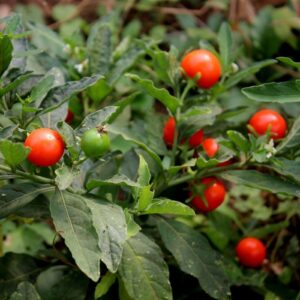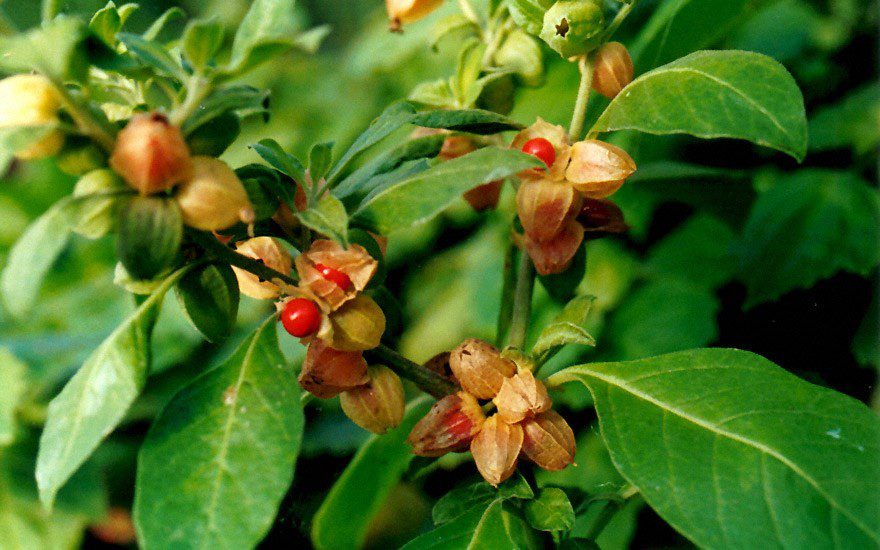Herb
Ashwagandha (Withania somnifera) Herb Ayurvedic Overview
Ashwagandha (Withania somnifera) is an evergreen woody shrub that grows up to 1.5 meters tall and is widely used in traditional medicines. It consists of dried mature roots of Withania somnifera Dunal. (Fam. Solanaceae). It is a perennial shrub, found in the wasteland, cultivated fields, and open grounds throughout India, widely cultivated in some regions of Madhya Pradesh and Rajasthan. The fruits and seeds of Ashwagandha (Withania somnifera) are diuretics, and leaves are anthelmintic, antipyretic, the root is adaptogenic, aphrodisiac, deobstruent.
The plant has perfect, actinomorphic flowers with five yellow petals, five green sepals, five stamens, and one pistil. The flowers of Ashwagandha (Withania somnifera) possess a superior ovary, which develops into an orange spherical berry, enveloped in a green, papery calyx. The fruit contains multiple yellow discoid seeds. The leaves are ovate and straightforward, and its root is a light brown, fleshy taproot.
Each part of this Ashwagandha (Withania somnifera) plant is used to manage several health conditions for many years and promote the longevity and vitality of an individual. Ayurveda has been using this powerful remedy from many years including, weak immunity, infertility, arthritis, depression, insomnia, mental disorders, general weakness, etc. Also, the analgesic and antioxidant properties of the leaves of Ashwagandha are used for treating a viral and seasonal infection, cough and cold symptoms, fever, and chronic pain. This amazing shrub is rich in antioxidant, anti-depressant, anti-diabetic, aphrodisiac, diuretic, anti-helminthic properties and is used to treat neural problems, constipation, skin disorders, etc.
Table of Contents
Scientific Classification of Ashwagandha (Withania somnifera):
- Kingdom: Plantae
- Subkingdom: Tracheobionta
- Division: Magnoliophyta
- Class: Magnoliopsida
- Subclass: Asteridae
- Order: Solanales
- Family: Solanaceae
- Genus: Withania
- Species: somnifera
Ashwagandha (Withania somnifera) Synonyms:
- Sanskrit: Hayagandhj, Vajini
- Assamese: Ashvagandha
- Bengali: Ashvagandha
- Gujrati: Asgandha
- Hindi: Asgandh
- Kannada: Angarberu, Hiremaddina-gida
- Kashmiri: Asagandh
- Malayalam: Amukkuram
- Marathi: Asagandha, Askagandha
- Oriya: Aswagandha
- Punjabi: Asgandh
- Tamil: Amukkaramkizangu
- Telugu: Pennerugadda
- Urdu: Asgand
Ashwagandha (Withania somnifera) Description:

a) Macroscopic: The root of Ashwagandha (Withania somnifera) is straight, unbranched, and thickness varying with age. Roots bear fiber-like secondary roots; the outer surface is having grey-yellow color with longitudinal wrinkles. The crown consists of 3-6 remains of stem base, stem bases variously thickened. Nodes are prominent where the petiole arises. It is cylindrical, green with longitudinal wrinkles, short and uneven, odor, the characteristic, the taste is bitter and acrid.
b) Microscopic: The transverse section of the root shows crushed when present isodiametric and non-lignified. The cork cambium is of 2-4 diffused rows of cells, and the secondary cortex contains about twenty layers of compact parenchymatous cells. The phloem consists of companion cells, phloem parenchyma, sieve tubes, cambium, 4-5 rows of tangentially elongated cells. The secondary xylem is hard, forming a closed vascular ring separated by multiseriate medullary rays, a few xylem parenchymas.
Identity, Purity, and Strength of Ashwagandha (Withania somnifera):
- Foreign matter Not more than 2 percent, Appendix 2.2.2.
- Total Ash Not more than 7 percent, Appendix 2.2.3.
- Acid-insoluble ash Not more than 1 percent, Appendix 2.2.4.
- Alcohol-soluble extractive Not less than 15 percent, Appendix 2.2.6.
- Water-soluble extractive Nil Appendix 2.2.7.
Chemical Constituents of Ashwagandha (Withania somnifera):
The main constituents of Ashwagandha are Alkaloids and withanolides. The roots contain a high abundance of essential volatile oils, amino acids, and alkaloids. In contrast, the fruits and leaves are rich in tannins and flavonoids, which helps eliminate free radical damage.
Ayurvedic Properties and Action of Ashwagandha (Withania somnifera):
- Rasa: Tikta, Kshaya
- Guna: Laghu
- Virya: Ushna
- Vipaka: Madhura
- Karma: Rasayana, Vatakapha hara, Balaya, Vajikaran, Ati Shukrala.
Ayurvedic Formulations of Ashwagandha (Withania somnifera):
Ashwagandharishta, Ashwagandhadi Leha, Balashwagandhadi Taila, Ashwagandha Churan.
Therapeutic Uses of Ashwagandha (Withania somnifera):
The most important therapeutic uses of Ashwagandha (Withania somnifera) are Varishya, Rasayana, Vajikaran, Shoph hara, Kandu hara, Shwashara, Pushtiprada, Kshata hara.
Dose of Ashwagandha (Withania somnifera):
3-6 gm of the drug in powder form.
Reference:
Ayurvedic Pharmacopeia of India.
For regular health updates, please follow our Social Pages


